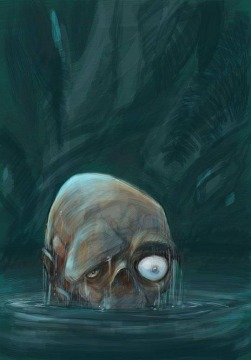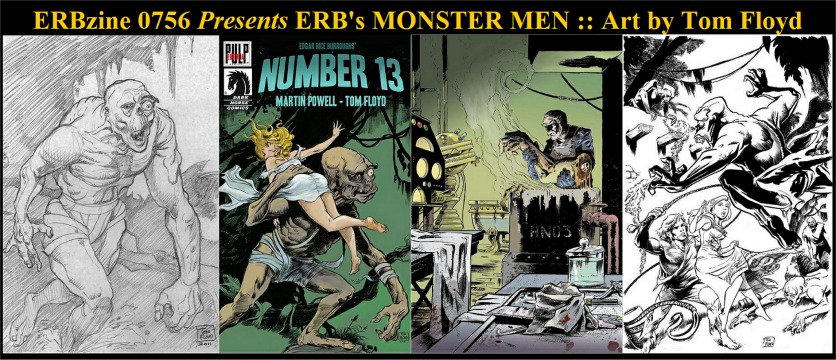THE MONSTER MEN ~ PART
6 OF 6 MONSTER MEANINGS
A Glossary of some of the uncommon terms ERB uses
in Monster Men:
* Bulan (Earlier referenced in Part 5 of 5, Monster
Mentionables) – Malaysian word for “moon,” usually a reference to “moon
goddess” in the Philippine language. Chapter IX states "Number Thirteen
noticed that when they addressed him it was always as Bulan, and upon questioning
them he discovered that they had given him this title of honor partly in
view of his wonderful fighting ability and partly because the sight of
his white face emerging from out of the darkness of the river into the
firelight of their blazing camp fire had carried to their impressionable
minds a suggestion of the tropic moon which they admired and reverenced."
* Cabalistic -- Relating to or associated
with mystical interpretation or esoteric doctrine. After burying "the heavy
chest" stolen from Professor Maxon, Ninaka and cohorts "buried the treasure
at the foot of a mighty buttress tree, and with his parang made certain
cabalistic signs upon the bole whereby he might identify the spot when
it was safe to return and disinter his booty." Chapter XIII
* Camphor Crystals -- A waxy, flammable, white
or transparent solid with a strong aromatic odor. It is found in the wood
of the camphor laurel, a large evergreen tree found in Asia (particularly
in Sumatra, Indonesia and Borneo) and also of the kapur tree, a tall timber
tree from the same region. It also occurs in some other related trees in
the laurel family, notably Ocotea usambarensis. Dried rosemary leaves,
in the mint family, contain up to 20% camphor. It is used for its
scent, as an ingredient in cooking (mainly in India), as an embalming fluid,
for medicinal purposes, and in religious ceremonies. "The head hunters
had been engaged in collecting camphor crystals when their quick ears caught
the noisy passage of the six while yet at a considerable distance, and
with ready parangs the savages crept stealthily toward the sound of the
advancing party." Chapter XI
* Celestial -- Sing Lee, the Chinese cook for the
Arthur Maxon scientific camp, is first referred to as an "oriental" and
then several times as a "celestial." Celestial was a term referring to
Chinese emigrants to the U.S., Canada and Australia during the 19th Century.
The term was widely used in the popular mass media of the day. The term
is from Celestial Empire, a traditional name for China. Chapter
VI, et al
* Cognomen -- An extra personal name given to an
ancient Roman citizen, functioning rather like a nickname and typically
passed down from father to son. "Both the name and the idea appealed
to Number Thirteen and from that time he adopted Bulan as his rightful
cognomen." Chapter IX
* Contumely -- Insolent or insulting language
or treatment. After Professor Maxon referred to Number Thirteen as "that
horrid, soulless thing,"..."At the very moment that he spoke the object
of his contumely was entering the dark mouth of a broad river that flowed
from out of the heart of savage Borneo." Chapter IX
* Court of Mystery -- Name coined by Von Horn for
the part of the compound where Maxon makes his monsters in his secret lab.
"For
days and nights at a time Virginia never saw him [her father, Professor
Maxon], his meals being passed in to him by Sing through a small trap door
that had been cut in the partition wall of the 'court of mystery' as Von
Horn had christened the section of the camp devoted to the professor's
experimentations." Chapter II, et al
* Dyak -- The Dayak or Dyak or Dayuh are the native
people of Borneo. It is a loose term for over 200 riverine and hill-dwelling
ethnic subgroups, located principally in the interior of Borneo, each with
its own dialect, customs, laws, territory and culture, although common
distinguishing traits are readily identifiable. ERB described the Dyak
pirates in terrifying terms, with tiger teeth sticking out of their faces.
* Effete -- We all are familiar with this
word from many of ERB's books, but what does it actually mean? The dictionary
says: "(of a person) affected, overrefined, and ineffectual." Chapter XV:
"At
the sight of the mighty figure reduced to pitiable inefficiency and weakness,
despite the knowledge that her protector could no longer protect, the fear
of the jungle faded from the heart of the young girl -- she was no more
a weak and trembling daughter of an effete civilization."
* Gudgeon -- A socket-like, cylindrical (i.e.,
female) fitting attached to one component to enable a pivoting or hinging
connection to a second component. The second component carries a pintle
fitting, the male counterpart to the gudgeon, enabling an interpivoting
connection that can be easily separated. Designs that may use gudgeon and
pintle connections include hinges, shutters and small boat rudders. "Here
he [Von Horn] found that the rudder [of the Ithaca] had been all but unshipped,
probably as the vessel was lifted over the reef during the storm, but a
single pintle remaining in its gudgeon." Chapter XI
* Gunung Tebor -- a locale in Indonesia. "...it
being Ninaka's intention to dispose of the contents of the chest as quickly
as possible through the assistance of a rascally Malay who dwelt at Gunung
Tebor, where he carried on a thieving trade with pirates." Chapter
XIII
* Incontinently -- In a way that lacks self-restraint,
no control (in modern sense, mostly refers to lack of control of bowels
or urination) "For a moment they stood valiantly before his attack,
but after two had grappled with him and been hurled headlong to the floor
they gave up and rushed incontinently out into the maelstrom of the screaming
tempest." Chapter VIII, et al.
* Kris (kriss) -- an asymmetrical dagger with distinctive
blade-patterning achieved through alternating laminations of iron and nickelous
iron (pamor). While most strongly associated with the culture of Indonesia
the kris is also indigenous to Malaysia, Thailand, Brunei and Singapore.
The kris is famous for its distinctive wavy blade, although many have straight
blades as well. Both the spelling of "kris" and "kriss" are used in “The
Monster Men.”
* Lascar -- A lascar was a sailor or militiaman
from the Indian Subcontinent or other countries east of the Cape of Good
Hope, employed on European ships from the Indian Subcontinent or other
countries east of the Cape of Good Hope. The word (also spelled lashkar,
laskar) derives from Persian laškar, meaning military camp or army, and
al-askar, the Arabic word for a guard or soldier. The Portuguese adapted
this term to lascarim, meaning an Asian militiaman or seaman, especially
those from the Indian subcontinent. Lascars served on British ships under
"lascar agreements." These agreements allowed shipowners more control than
was the case in ordinary articles of agreement. The sailors could be transferred
from one ship to another and retained in service for up to three years
at one time. The name lascar was also used to refer to Indian servants,
typically engaged by British military officers. In “The Monster Men,” ERB
uses the term to refer to refer to some of the natives who assisted, as
well as attacked, the expedition. "The gravel bottom of the rivulet
made fairly good walking, and as Virginia was borne in a litter between
two powerful lascars it was not even necessary that she wet her feet in
the ascent of the stream to the camp." Chapter II
* Malay -- Member of an ethnic group
of Austronesian peoples predominantly inhabiting the Malay Peninsula, eastern
Sumatra, southernmost parts of Thailand, south coast Burma, island of Singapore,
coastal Borneo including Brunei, West Kalimantan, and coastal Sarawak and
Sabah, and the smaller islands which lie between these locations -- that
collectively are known as the Alam Melaya. These locations today are part
of the modern nations of Malaysia, Indonesia, Singapore, Brunei and Thailand.
Numerous mentions throughout book; along with the Dyaks, the chief antagonists
of the expedition.
* Mias pappan -- A native name for the orangutan.
"As she looked she saw a huge mias pappan cross the stream, bearing in
his arms the dead, or unconscious form of a white-skinned girl with golden
hair." This was a Virginia sighting later reported to von Horn by
an unidentified native woman. Chapter XII
Nostrum -- A medicine, especially one that is not
considered effective, prepared by an unqualified person. Sing Lee's "first
thought when he had made Professor Maxon comfortable upon the couch was
to fetch his pet nostrum, for there burned strong within his yellow breast
the same powerful yearning to experiment that marks the greatest of the
profession to whose mysteries he aspired." Chapter VII
* Ourang outang -- Was apparently a popular
spelling of the name of beast more commonly rendered as orangutan today.
First used in “The Monster Men” as a hyphenated word and thereafter as
two words. This was the spelling in Poe's Murders in Rue Morgue, published
in 1841. Chapter X.
* Panglima -- A Malay noble of secondary
rank, a petty raja. The word has also been used as the name for a "fun,
fast vocabulary game." This is the rank of Ninaka of the Sibnana Dyaks,
cohort and rival of Rajah Muda Saffir, chief villain. Chapter X
* Parang -- A collective term for swords, big knives
and machetes hailing from all over the Malay archipelago. Used throughout
the story. One example: "They had entered a narrow canon when Number
Twelve went down beneath a half dozen parangs." Chapter XIV
* Pintle -- See gudgeon, above
* Prahu -- A type of sailing boat originating in
Malaysia and Indonesia that may be sailed with either end at the front,
typically having a large triangular sail and an outrigger. Used throughout
the book.
* Sumpitan -- A kind of blowgun for discharging
arrows, - used by the savages of Borneo and adjacent islands. Definition
evident from context: "A shower of poisoned darts blown from half a hundred
sumpitans fell about them, and then Muda Saffir called to his warriors
to cease using their deadly blow-pipes lest they kill the girl." Chapter
XIV
* Tuan Besar -- A European boss in colonial Malaysia,
used twice in Chapter XI to refer to Von Horn. The first time it is used
in the original editions, it is misspelled as "Taun."
* USS New Mexico-- A battleship (BB-40) in service
with the U.S. Navy from 1918 to 1946. She was the lead ship of a class
of three battleships. New Mexico was extensively modernized between 1931
and 1933 and served in World War II in both the Battle of the Atlantic
and the Pacific Theater. After her decommissioning she was scrapped in
1947. New Mexico was the first US Navy ship named for the U.S. state of
New Mexico. The second such ship is a Virginian Class submarine (SSN 779)
placed in service March 27, 2010. Since the book version of “The Monster
Men” came out in 1929, it would have been logical for readers to assume
BB-40 was meant. However, the story was first published in All-Story magazine
in 1913. So, the name with which ERB christened his ship was fictional,
at the time. Five years later, a real USS New Mexico was launched by the
Navy.
ERB identifies his New Mexico as "flagship of the
Pacific Fleet," which would usually mean it was a rather large ship with
an admiral aboard. The one in his story, however, is identified as a cutter,
a much smaller and more maneuverable fighting ship. And that would be smaller,
as well, than the battleship which eventually bore that name. Chapter XVII
And it’s a pleasure to note that ERB gathered together
all of these unusual words – many not generally known in America at the
time – without the aid of the internet!!

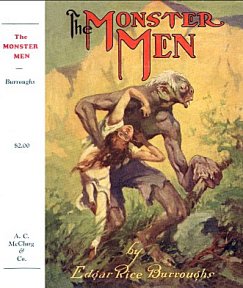
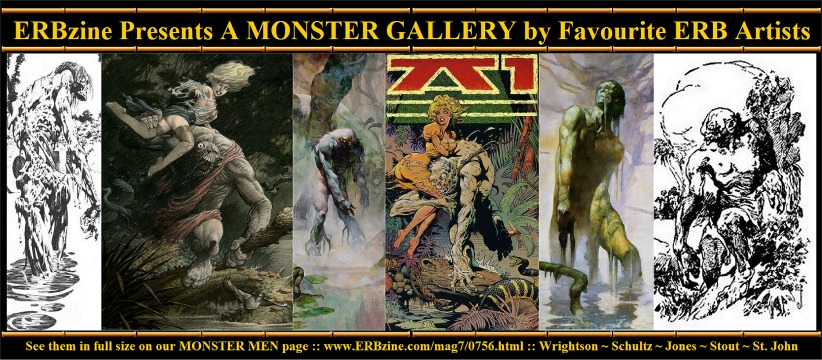
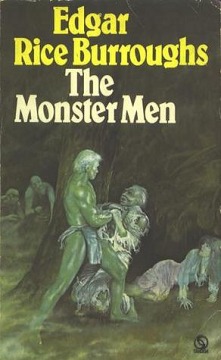 .
.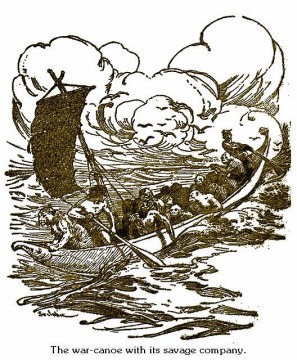
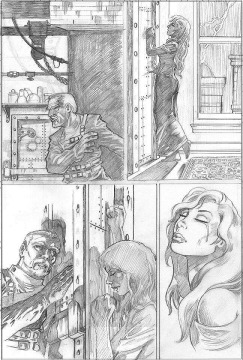
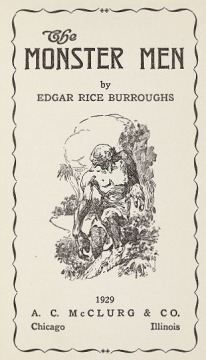 .
.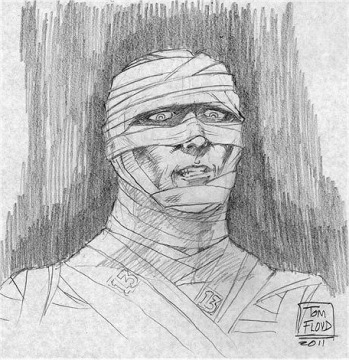
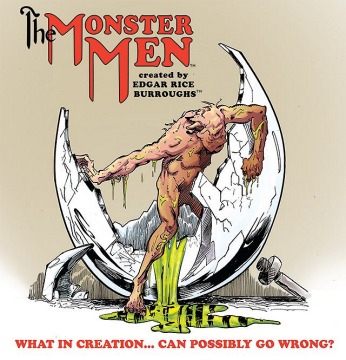
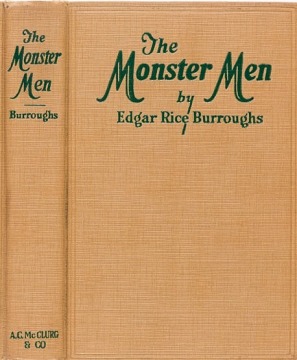 .
.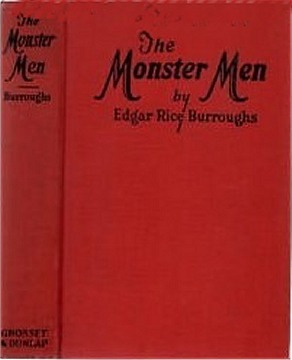
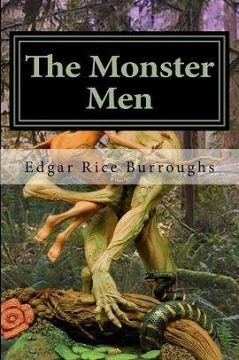 .
.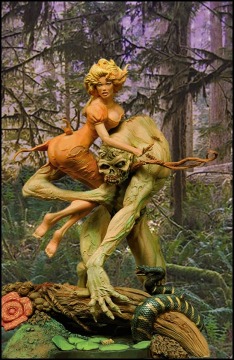
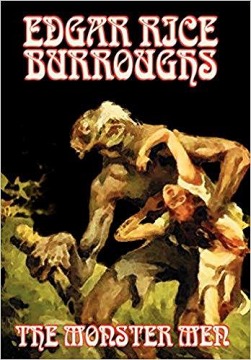 .
.